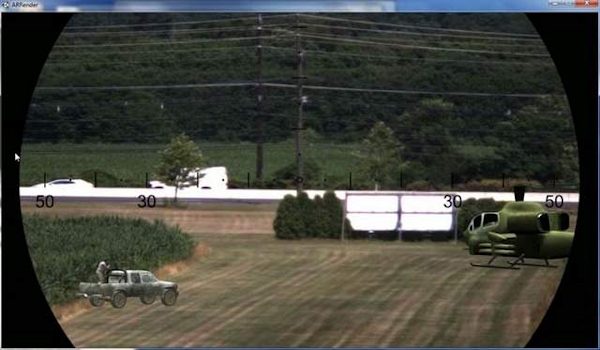[From Defense News]
[Image: The Augmented Immersive Team Training system superimposes objects, such as vehicles or munitions, on the real-life terrain that is viewed through a head-mounted display. (Office of Naval Research)]
Marines Get Virtual Explosions in the Real World
Sep. 13, 2012
By Michael Peck
The U.S. Marine Corps has unveiled a prototype training system that uses augmented reality to digitally superimpose objects upon a real landscape. This differs from the virtual reality used by programs such as the Army’s freshly fielded Dismounted Soldier Training System, which transports the user into a fake world.
The Marines recently demonstrated the Augmented Immersive Team Training (AITT) system, a five-year research project being conducted by the Office of Naval Research on behalf of the Marine Corps. AITT is a lightweight, portable training system that doesn’t require special virtual reality facilities.
The system includes a head-mounted display (HMD) with attached sensors tethered to a backpack computer. The software projects scaled virtual images of objects, such as tanks or helicopters, against the backdrop of the real terrain as seen through the HMD. It can work on any terrain, though the terrain must first be mapped.
“This is a real game-changer,” said Pete Muller, president of Potomac Training Corporation and a contractor for the ONR. “The Army is fielding a virtual reality system. This is a whole generation beyond that. The big problem with virtual reality is locomotion. You really can’t move around naturally using a thumb and a joystick.”
The projected cost for the research and development of the AITT system, including five anticipated prototype systems, is roughly $10 million.
The prototype is currently optimized for calls-for-fire training for Joint Terminal Attack Controllers (JTAC). It was demonstrated earlier this month at the Princeton, N.J., site of SRI International, which is participating in the project along with ONR, Lockheed Martin, and the University of Central Florida. Two simple JTAC scenarios were demoed on Aug. 23: an artillery call for fire and an air strike by a Marine F-18 Hornet. AITT adjudicates whether virtual rounds impact near live or virtual targets, and by what distance. The system can also work with live fire and real entities, such as helicopters, though so far it has been tested only with simulated entities.
Working with virtual fire in a live setting offers huge savings by reducing the need for instrumented ranges, live aircraft and munitions, and travel costs to training bases, said Peter Squire, ONR’s program manager for human performance training and education.
Mueller said he has been expecting the advent of military augmented reality for years, but that deployment has been delayed by technological challenges such as head-mounted displays and tracking technology.
“Tracking technology is the real breakthrough that ONR had made,” he said. “We don’t need any external tracking system. Just a camera and a few sensors that know exactly where the head is looking.”
There are still questions about augmented reality, especially concerning potential safety issues with mixing virtual fires with real terrain and soldiers. Squire says this will ultimately be a policy determination, but it will be hard to mistake virtual for real objects because the graphics are not sufficiently lifelike except at long distances. Trainers can take other measures to improve safety.
“One of the beauties of augmented reality is that we can specially mark targets as simulated any way we want, if it is important for training or safety,” said Squire. “So we can put a blue circle, for example, around all simulated entities.”
Capt. Frank Furman, the military deputy in ONR’s expeditionary maneuver warfare and combating terrorism department (logistics thrust), said AITT has potential.
“There’s still work to be done, but you can see the promise in it,” said Furman, who formerly commanded a Marine weapons company where he helped run JTAC certification. He said that current JTAC training is hampered by so many factors, such as cost or location restrictions, that sometimes training doesn’t take place.
AITT has its roots in the late Joint Forces Command’s ONR/Marine Future Immersive Training Environment (FITE), a demonstration of various training technologies that included virtual and augmented reality.
Kristen McCullough, a spokeswoman for the Army’s Program Executive Office for Simulation, Training and Instrumentation, said that PEO STRI “also sees the value of augmented reality training, and we’ve fielded the Range 37 Shoothouse to the U.S. Special Operations Command that integrates virtual targets into a live-fire, MOUT training facility.”
Mueller believes augmented reality is the wave of the future.
“Five or 10 years from now, we’re going to wear those glasses, and information will available to us at all times.”
